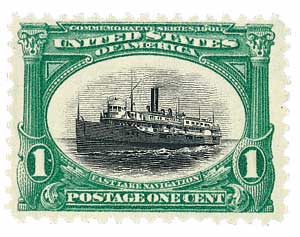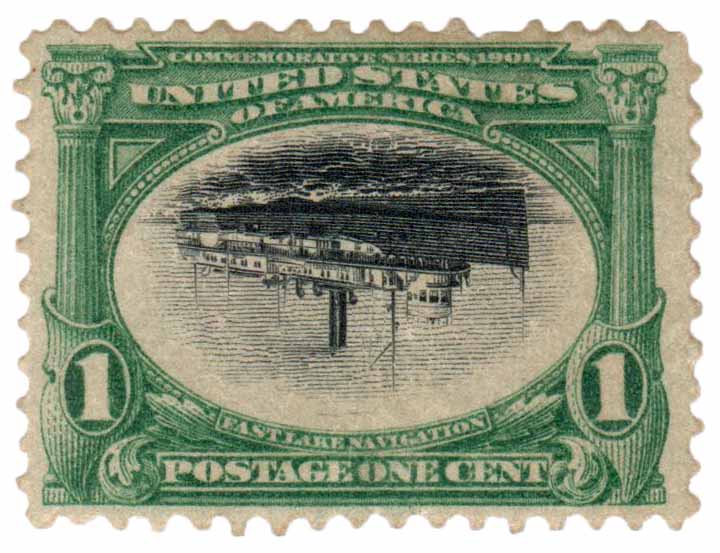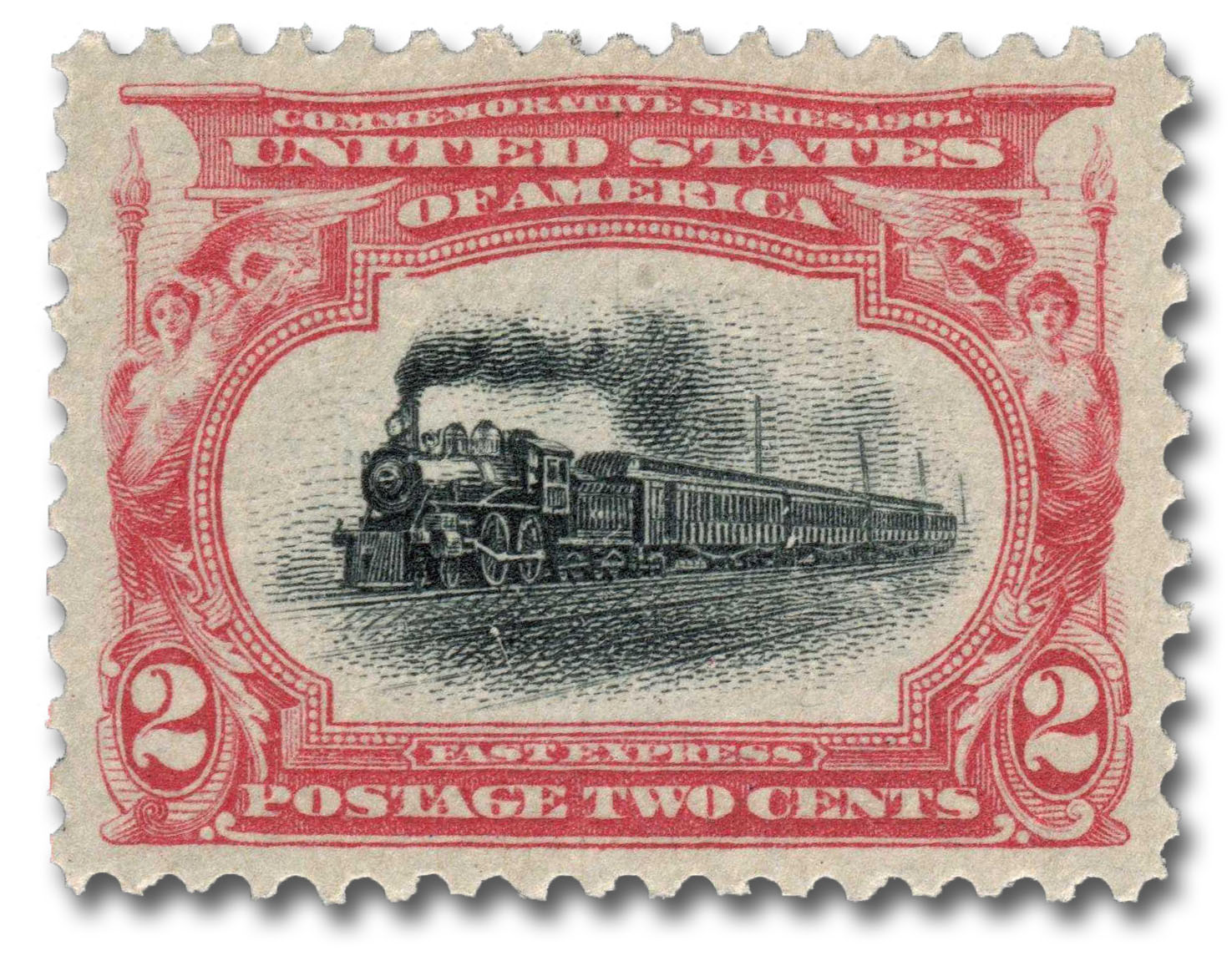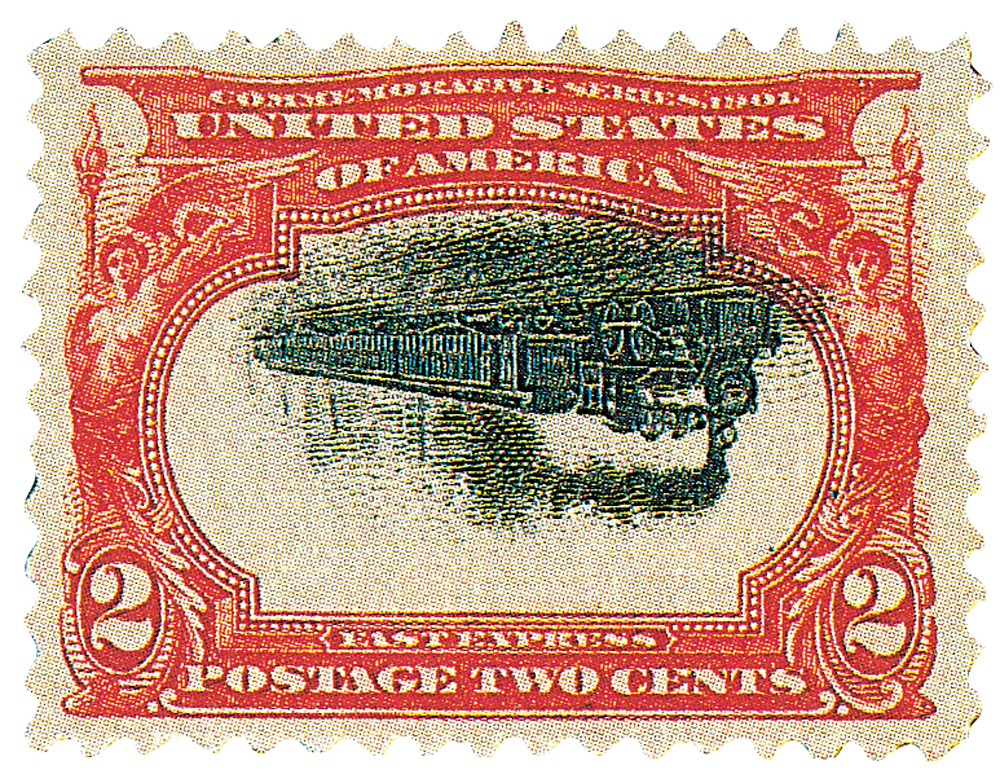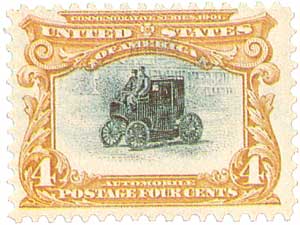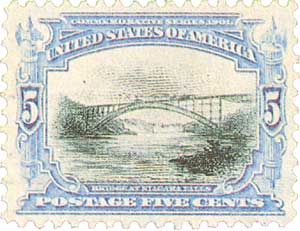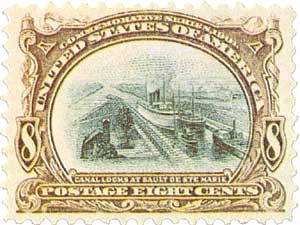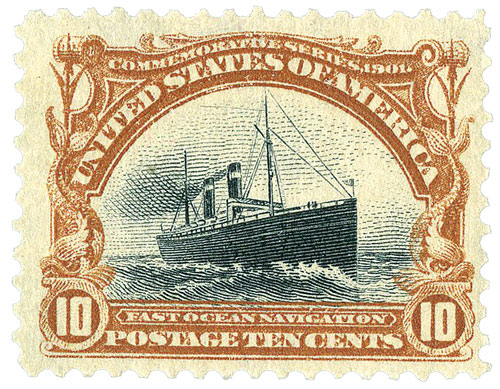
# 299 - 1901 10¢ Pan-American Exposition: Fast Ocean Navigation
1901 10¢ Pan-American Commemorative
Issue Date: May 1, 1901
Quantity issued: 5,043,700
Printed by: Bureau of Engraving and Printing
Method: Flat plate
Watermark: Double line
Perforation: 12
Color: Yellow brown and black
Pan-American Exposition & Stamps
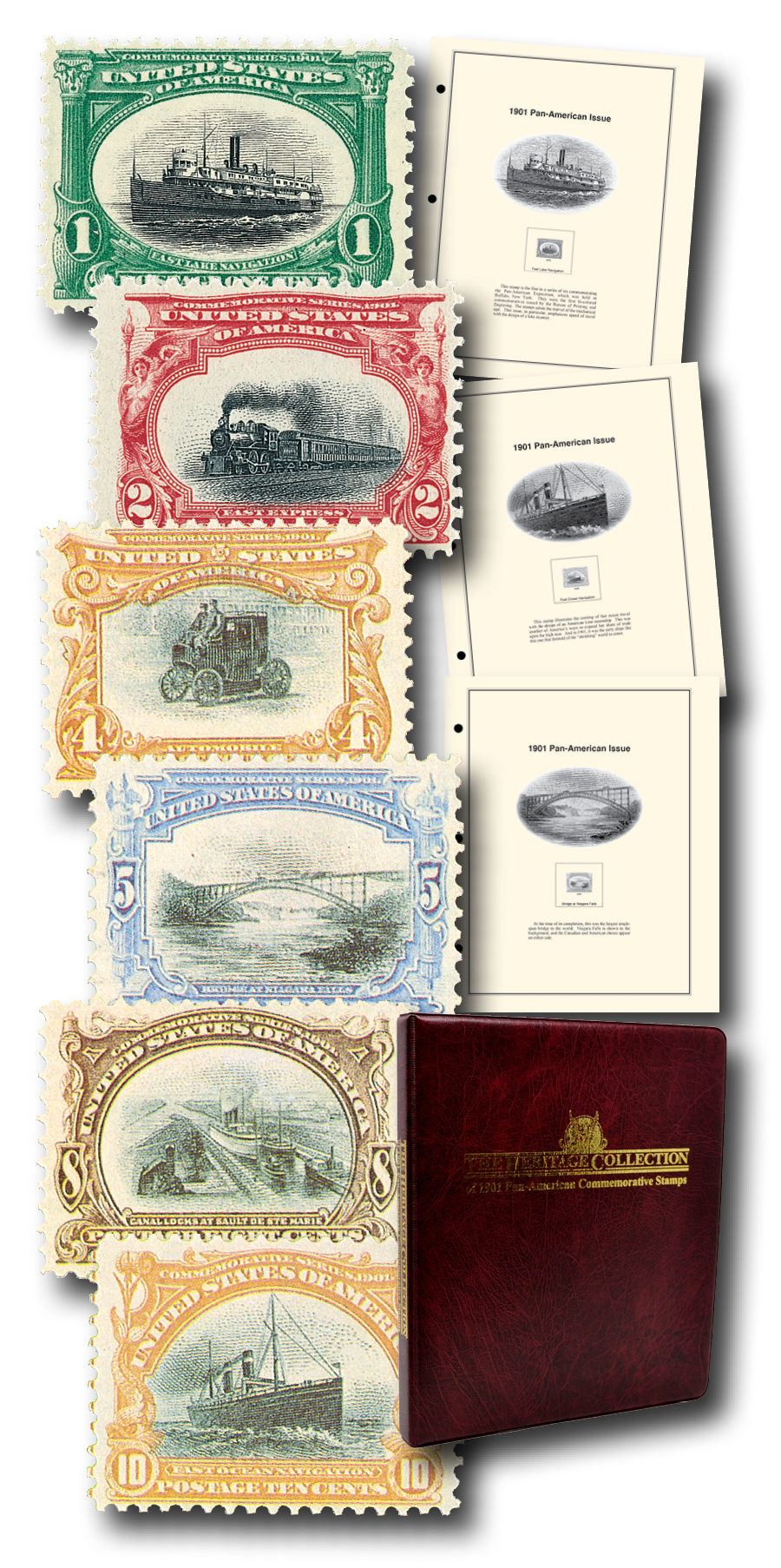
The Pan-American Exposition opened to the public on May 1, 1901, in Buffalo, New York. That same day the set of six Pan-American stamps went on sale. They were the first commemoratives and bi-color stamps of the 20th century. They also produced several highly sought-after inverts.
The 1901 Pan-American Exposition is remembered in the history books for many reasons. First, it was a salute to the engineering achievements that had taken place in America and the New World. It was the dawn of a new century, the beginning of an industrial age, and people were dazzled and excited about all the wonderful inventions that were coming into their lives.
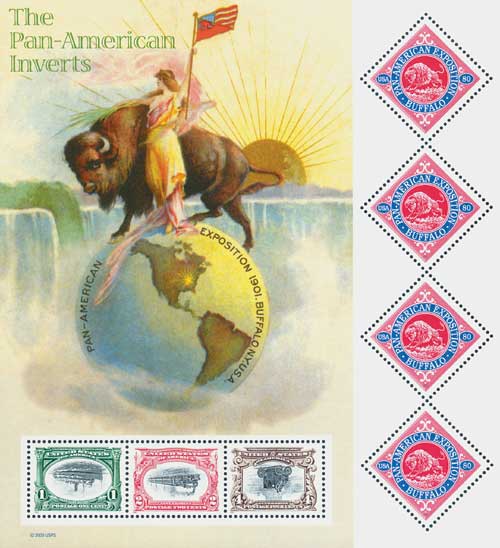
Running from May 1 through November 2, the exposition spanned 342 acres. One of the exposition’s major features was its use of electric lighting, created by hydroelectric power from nearby Niagara Falls. Additionally, many companies offered “working exhibits” that not only informed visitors, but also helped the exposition to function. Some of the new inventions on display included the electrograph, telautograph, voting machine, mutoscopes, a mechanical mowing machine, a typesetting machine and an envelope-making machine.
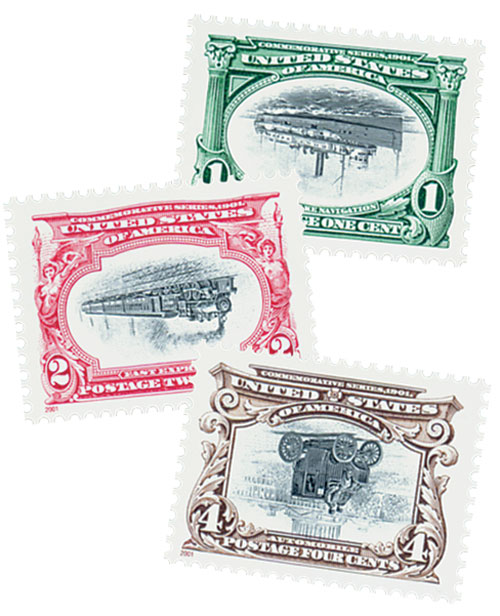
The Exposition was also an effort to promote better relations between North and South America. America’s 25th President, William McKinley, gave one of the most important speeches of his Presidency when he announced a change in his high-tariff isolationist trade policies. “…by sensible trade relations which will not interrupt our home production, we shall extend the outlets of our increasing surplus… The period of exclusiveness is past.”
Unfortunately, the events of the Pan-American Exposition took a sad turn on September 6, 1901. The day after giving his speech, President McKinley held a public reception at the Exposition’s Temple of Music. As the President shook hands with members of a large crowd that had gathered to meet him, Leon F. Czogosz extended his arm to the President and fired two shots from a pistol concealed under a handkerchief. Although one of the bullets only grazed McKinley, the second hit him squarely in the abdomen. Despite signs of recovery, President McKinley passed away on September 14, 1901. Vice President Theodore Roosevelt took the oath of office and became President. Czogosz was later executed for his crime.
| Click any of these images on this page to learn more about the individual stamps and find different conditions. |
Pan-American Stamps And Inverts
Knowing the Pan-American Exposition event would be like no other ever seen, the promoters of the Exposition requested a series of commemorative stamps appropriate for such an event. And although the original inscription for the stamps, “Pan-American Series of 1901,” was changed to “Commemorative Series of 1901” (the Assistant Attorney General thought the original inscription served as an advertisement), a series of six stamps was issued with bi-color designs. They were to be the first bi-color stamps issued since the famous 1869 Pictorials produced by the American Bank Note Company.
Because the Pan-American stamps were bi-color, two different plates were needed for each stamp – one for the frame and the other for the central design, or vignette. What makes the Pan-Americans even more special is that in addition to each vignette being unique, each of the frames is also unique. The bi-color Pan-Americans were printed in two steps. In the first, the vignette (center design) was printed in black ink. The frame was then printed in a second color. This process made it very difficult for the printer to align the frame evenly. As a result, several stamps feature frames that aren’t aligned properly, and inverts were created when the sheet was mistakenly fed into the press backwards.
Shortly after the series was issued, inverts were found among the 1¢ and 2¢ denominations. Reports of the discovery of 4¢ inverts reached postal officials, who reacted by deliberately creating two sheets of 200 inverted stamps each. Collectors were outraged by the intentional manipulation of the stamp market, prompting the government to abandon its plan to create 5¢, 8¢, and 10¢ inverts as well.
The Pan-American commemoratives were issued on May 1, 1901, the first day of the Expo, and sold until the last day on October 31, 1901, when the remaining stamps were destroyed. So each of these historic stamps remained on sale for just six months. Because no sales records were kept, no one knows for sure how many of these stamps went unsold.
Click here for a full website dedicated to the exposition.
1901 10¢ Pan-American Commemorative
Issue Date: May 1, 1901
Quantity issued: 5,043,700
Printed by: Bureau of Engraving and Printing
Method: Flat plate
Watermark: Double line
Perforation: 12
Color: Yellow brown and black
Pan-American Exposition & Stamps

The Pan-American Exposition opened to the public on May 1, 1901, in Buffalo, New York. That same day the set of six Pan-American stamps went on sale. They were the first commemoratives and bi-color stamps of the 20th century. They also produced several highly sought-after inverts.
The 1901 Pan-American Exposition is remembered in the history books for many reasons. First, it was a salute to the engineering achievements that had taken place in America and the New World. It was the dawn of a new century, the beginning of an industrial age, and people were dazzled and excited about all the wonderful inventions that were coming into their lives.

Running from May 1 through November 2, the exposition spanned 342 acres. One of the exposition’s major features was its use of electric lighting, created by hydroelectric power from nearby Niagara Falls. Additionally, many companies offered “working exhibits” that not only informed visitors, but also helped the exposition to function. Some of the new inventions on display included the electrograph, telautograph, voting machine, mutoscopes, a mechanical mowing machine, a typesetting machine and an envelope-making machine.

The Exposition was also an effort to promote better relations between North and South America. America’s 25th President, William McKinley, gave one of the most important speeches of his Presidency when he announced a change in his high-tariff isolationist trade policies. “…by sensible trade relations which will not interrupt our home production, we shall extend the outlets of our increasing surplus… The period of exclusiveness is past.”
Unfortunately, the events of the Pan-American Exposition took a sad turn on September 6, 1901. The day after giving his speech, President McKinley held a public reception at the Exposition’s Temple of Music. As the President shook hands with members of a large crowd that had gathered to meet him, Leon F. Czogosz extended his arm to the President and fired two shots from a pistol concealed under a handkerchief. Although one of the bullets only grazed McKinley, the second hit him squarely in the abdomen. Despite signs of recovery, President McKinley passed away on September 14, 1901. Vice President Theodore Roosevelt took the oath of office and became President. Czogosz was later executed for his crime.
| Click any of these images on this page to learn more about the individual stamps and find different conditions. |
Pan-American Stamps And Inverts
Knowing the Pan-American Exposition event would be like no other ever seen, the promoters of the Exposition requested a series of commemorative stamps appropriate for such an event. And although the original inscription for the stamps, “Pan-American Series of 1901,” was changed to “Commemorative Series of 1901” (the Assistant Attorney General thought the original inscription served as an advertisement), a series of six stamps was issued with bi-color designs. They were to be the first bi-color stamps issued since the famous 1869 Pictorials produced by the American Bank Note Company.
Because the Pan-American stamps were bi-color, two different plates were needed for each stamp – one for the frame and the other for the central design, or vignette. What makes the Pan-Americans even more special is that in addition to each vignette being unique, each of the frames is also unique. The bi-color Pan-Americans were printed in two steps. In the first, the vignette (center design) was printed in black ink. The frame was then printed in a second color. This process made it very difficult for the printer to align the frame evenly. As a result, several stamps feature frames that aren’t aligned properly, and inverts were created when the sheet was mistakenly fed into the press backwards.
Shortly after the series was issued, inverts were found among the 1¢ and 2¢ denominations. Reports of the discovery of 4¢ inverts reached postal officials, who reacted by deliberately creating two sheets of 200 inverted stamps each. Collectors were outraged by the intentional manipulation of the stamp market, prompting the government to abandon its plan to create 5¢, 8¢, and 10¢ inverts as well.
The Pan-American commemoratives were issued on May 1, 1901, the first day of the Expo, and sold until the last day on October 31, 1901, when the remaining stamps were destroyed. So each of these historic stamps remained on sale for just six months. Because no sales records were kept, no one knows for sure how many of these stamps went unsold.
Click here for a full website dedicated to the exposition.









